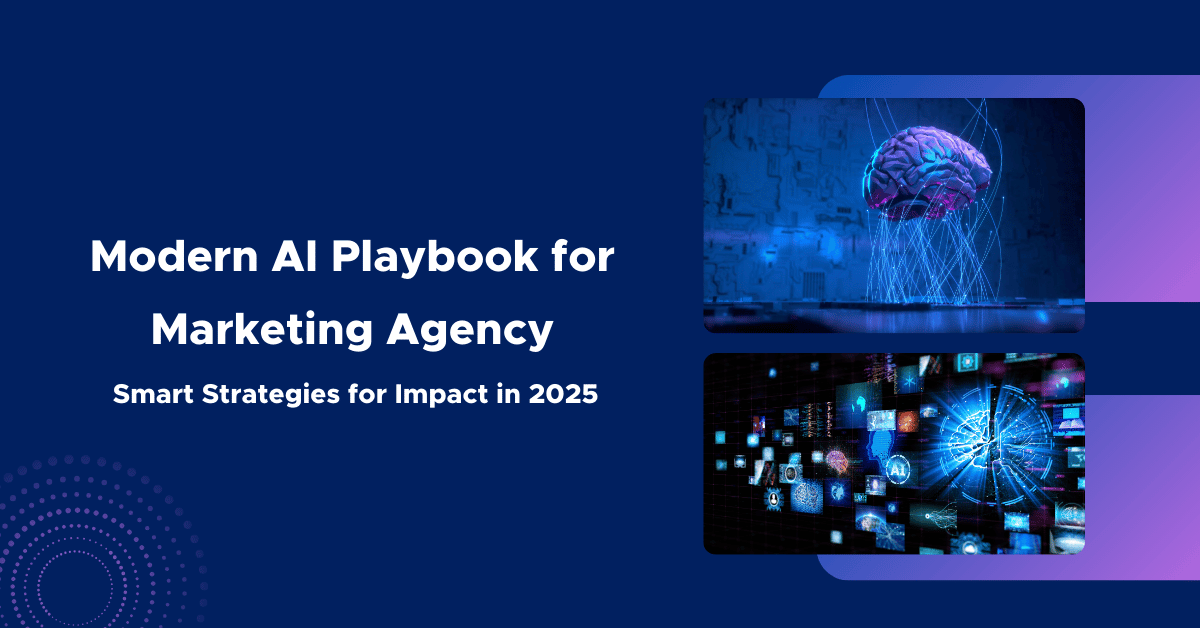
In an ever-shifting digital landscape, artificial intelligence (AI) isn’t just a trend, it’s now central to how marketing agencies do well. AI has gone far beyond buzzwords, becoming a powerful force that agencies must connect strategically, creatively, and properly. But adapting to AI doesn’t mean replacing human insight; it means sharpening it with new tools.
In this guide, we’ll explore smart, human-first ways to weave AI into your agency’s workflow from refining data to empowering creativity so you can lead confidently into the future.
- Tidy and Centralise Your Data First
Think of clean data as the foundation of effective AI workflows. Disorganized spreadsheets or siloed reports only muddy outputs and slant insights. Centralizing your marketing data campaign results, customer behavior, performance metrics into a unified system sets the stage for AI tools to work meaningfully.
Once your data is organized and standardized, real-time AI models can pull insights like campaign conversion rates or customer engagement trends with clarity and trust-building precision.
- Use AI to Automate, Not Just Generate
AI excels at eliminating repetitive tasks, email drafting, report summaries, A/B testing logistics freeing your team to focus on strategy and storytelling. Let AI handle the grunt work while your team drives the vision.
This shift isn’t about cutting jobs it’s about elevating the role of human creativity and deep connections with clients and audiences.
- Blend AI with Human Creativity for Ethically Rich Work
AI-generated content can feel polished but impersonal. That’s why the magic happens when a human improves AI output with realistic voice, brand tone, and moral reach. Always layer in human editorial judgment before deploying AI-generated copy or visuals.
In fact, that creative tension between AI and human input often yields the most innovative and respectful brand messaging.
- Watch for Bias and Demand Transparency
AI models learn from existing data, and that means they can reflect or magnify biases. Whether it’s demographic targeting, tone, or representation, marketers must audit for fairness and inclusivity.
Always ask: Can I explain why this AI recommended this outcome? If not, pause. Transparency isn’t just legal it’s a trust-builder.
- Invest in Your Team’s AI Know-How
Many agencies underperform with their AI because they treat it as a tool, not a discipline. Training your team to truly understand how AI thinks, fails, and learns elevates the agency’s offering and protects client outcomes.
Make AI literacy part of your regular training ask questions like: “What prompts work best?”, “When is human judgment mandatory?”, “How do we measure AI output value?”
- Optimize for AI-First detection (Generative Engine Optimization)
Visibility no longer means ranking on page one. Increasingly, brands need to show up in AI-generated answers from platforms like ChatGPT or Google’s AI Overviews. That’s where Generative Engine Optimization (GEO) comes in.
Ensure your content is structured, factual, and aligned with human intent not just keyword-stuffed. This makes AI more likely to surface your brand in voice search or AI summarizations.
- Put Customers First with Personalization Powered by AI
AI’s ultimate marketing superpower is personalization making each campaign feel suitable at scale. By analyzing behavior, intent, and preferences, AI can guide dynamic emails, product recommendations, or ad messaging that genuinely resonates.
Yet personalization must always be paired with transparency and consent, respecting privacy norms and building long-term trust.
- Use “Explainable AI” to Build Trust
In client discussions and campaign reporting, being able to explain AI decisions matters. Transparent AI, where you can trace how and why certain ads were targeted, or why a message was customized, makes it easier to get client buy-in and justify strategy.
Explainability isn’t an afterthought, it’s how you retain credibility in an AI-first world.
- Launch Small Then Scale Smartly
Don’t throttle your agency into chaos by pushing everything through AI overnight. Start with a pilot maybe automating reports or testing AI-generated blogs and track performance, speed, feedback. Gradually expand AI use as your team gains comfort and trust.
This growth mindset prevents disruption while building a durable AI toolkit
- Lead with Empathy not Automation
Finally, AI should never replace human care. Use it to enhance empathy, not dilute it. Whether it’s crafting thoughtful client emails, building inclusive visuals, or responding to sensitive remarks, human warmth can’t be replicated by a machine.
As AI handles distribution and optimization, humans remain essential for purpose, conscience, and connection.
Conclusion
AI has arrived and it’s here to stay. But agencies that excel in the long run will be those that pair smart tech adoption with savvy human insight. Clean data, ethical filters, thoughtful creativity, and a culture of ongoing AI learning are the real game-changers.
With this AI playbook humane, strategic, and future-ready you’ll lead with clarity, creativity, and confidence in the era of intelligent marketing.

Comments are closed